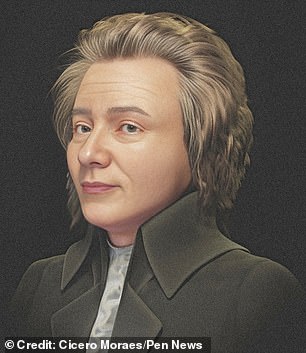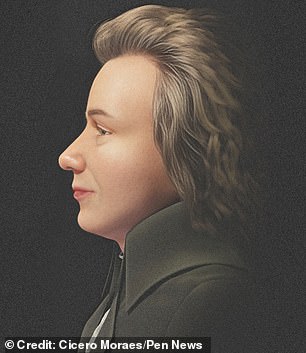The mystery of how Mozart truly looked may be solved at last, after scientists reconstructed his living face from his skull.
The composer is a giant of western music, but his appearance is shrouded in mystery, with most portraits of him painted long after his death.
And the few depictions of him that survive from his life vary, with some showing him in childhood, others incomplete, and others disputed in their authenticity.
In 1962, musicologist Alfred Einstein wrote: ‘No earthly remains of Mozart survived save a few wretched portraits, no two of which are alike.’
But now the face of the famous classical musician may be revealed at last, after a skull attributed to him was used to rebuild his likeness.
Cicero Moraes, an expert in the field of forensic facial reconstructions, said he learned of the skull by sheer luck while engaged in another project.
He said: ‘Our team has been working for over a decade on facial approximations, occasionally helping police forensic teams and constantly reconstructing historical figures.
‘During previous studies, we discovered by chance that there was a skull attributed to Mozart.’

The mystery of how Mozart truly looked may be solved at last, after scientists reconstructed his living face from his skull


The face of the famous classical musician may be revealed at last, after a skull attributed to him was used to rebuild his likeness
He continued: ‘There were images of the skull with spatial references so it was possible to reconstruct it.
‘The condition was good, although the mandible was not included and some teeth were missing.
‘But it was possible to reconstruct these and recover the complete skull through statistical data and anatomical coherence.’
The international team began by virtually rebuilding the skull.
Then different techniques were combined to give a finished reconstruction.
Mr Moraes, lead author of the new study, said: ‘We used soft tissue thickness markers, which allowed us to get an idea of the limits of the skin on the face.
‘We also projected some structures such as the nose, ears, lips, etc.
‘Both were based on measurements taken from hundreds of adult European individuals, providing a robust basis for approximation.’

The international team began by virtually rebuilding the skull. Then different techniques were combined to give a finished reconstruction

Perhaps the most famous portrait of Mozart, painted 28 years after his death by Barbara Krafft
He continued: ‘To complement the data, we also used the anatomical deformation technique, adjusting the head of a virtual donor to match the parameters of the skull attributed to Mozart.
‘In this way a compatible face would be generated.
‘After crossing all the data, we had a basic bust, which was finished with the placement of hair and clothing according to references from the time.’
The completed face had a ‘gracile’ look, he said.
The mystery of Mozart’s appearance has long puzzled academics.
Alfred Einstein once wrote: ‘We have nothing to give us an idea of Mozart’s physical appearance, except for a few mediocre canvases that do not even resemble each other.’
Musicologist, Arthur Schuring, took a similar view.
He wrote in 1913: ‘Mozart has been the subject of more portraits quite unrelated to his actual appearance than any other famous man.
‘An adoring posterity has not conceived a more incorrect physical image of any other notability.’
Mr Moraes noted that the most famous portrait of Mozart, by Barbara Krafft, was painted in 1819 – 28 years after the composer’s death.
However, the new reconstruction was a good match for two portraits that survive from the composer’s lifetime.
One was an unfinished portrait by Joseph Lange, circa 1783, which was described by Mozart’s wife, Constanze, as ‘by far the best likeness of him’.
The other was a sketch by Dora Stock from 1789.
Mr Moraes said: ‘In the facial approximation process, we did not use them as a modelling reference, since the parameters must follow published and peer-reviewed techniques.
‘Only after we finished the bust could we compare it with his images.
‘In this case, it was quite compatible with both works.’
The skull itself is not without controversy however.
It was supposedly recovered 10 years after Mozart’s death by a gravedigger who recalled the location of his unmarked grave in Vienna.

The mystery of Mozart’s appearance has long puzzled academics. Pictured: an unfinished portrait of Mozart by Joseph Lange, circa 1783
From there it passed through various hands, before being donated to the Mozarteum in Salzburg in 1902.
Numerous studies since have reached different conclusions about whether it’s the genuine article.
Mr Moraes said: ‘What we do know is that the skull has characteristics compatible with the portraits of him in life.
‘Although this is not proof, it is yet another element that increases the mystery.’
Regardless, the Brazilian graphics expert counts himself lucky to work on such a famous face.
He said: ‘Personally I feel very honoured.
‘I am an enthusiast of classical music, listening to it almost every day, and occasionally Mozart makes an appearance on my playlist.’
Mozart died in Vienna on December 5, 1791, at the age of 35.
His cause of death is uncertain.
Mr Moraes’ co-authors include archaeologists Michael Habicht and Elena Varotto, of Flinders University in Australia, and Luca Sineo, of the University of Palermo in Italy.
There was also Thiago Beaini, of Brazil’s University of Uberlândia, Francesco Maria Galassi, of the University of Lodz in Poland, and Jiří Šindelář, from GEO-CZ, a Czech heritage preservation firm.
They published their study in the journal, Anthropological Review.












